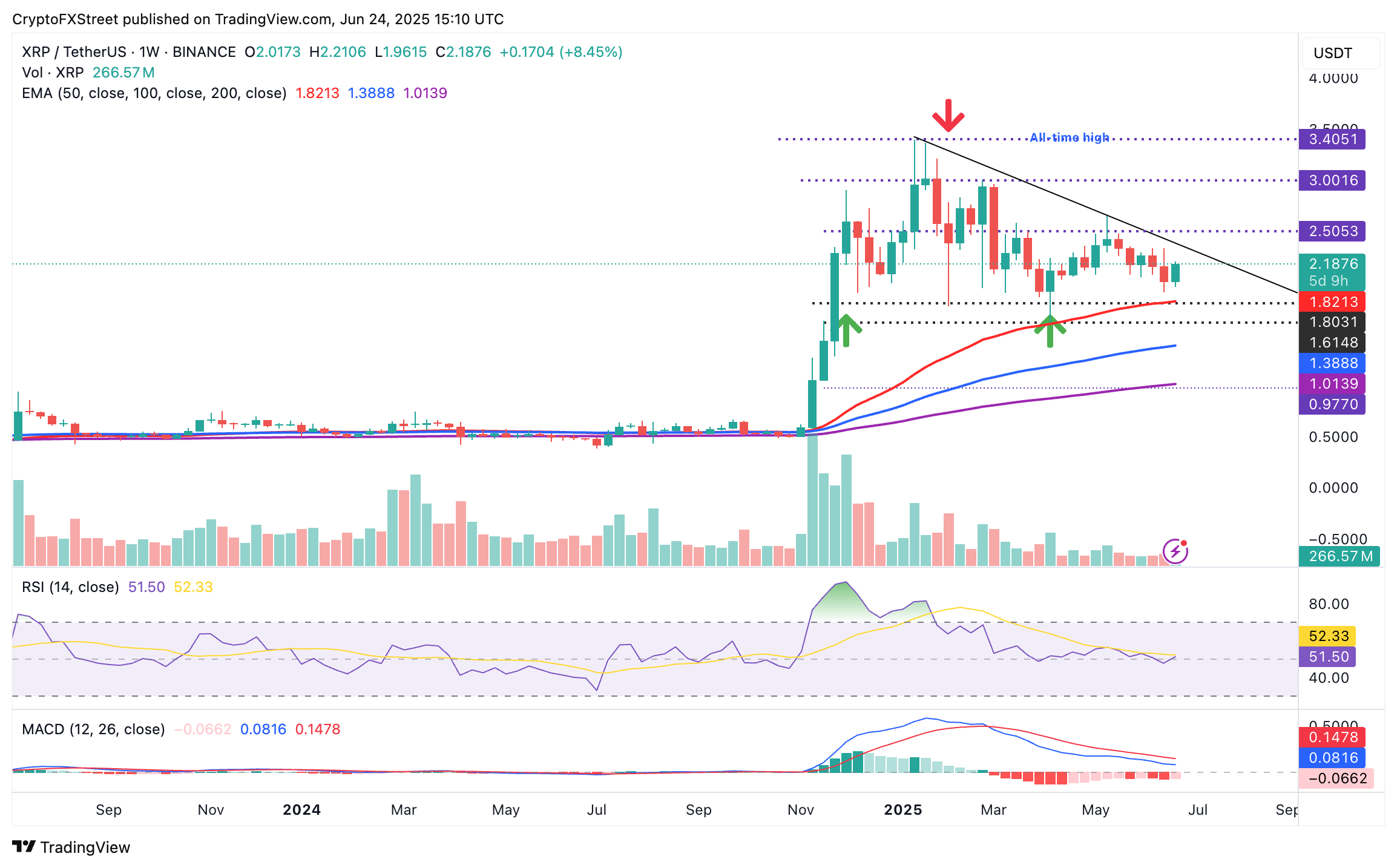Ripple Price Forecast: XRP retains bullish potential on robust derivatives market, ceasfire
- XRP extends gains above $2.00 as markets shift focus from Middle East tensions to Fed Chair Jerome Powell.
- Powell insists that interest rate cuts can wait as the tariffs imposed by the US will likely push prices up while slowing economic activity.
- XRP eyes a technical breakout toward $3.00, backed by a robust derivatives market.
Ripple (XRP) upholds a bullish outlook on Tuesday after extending Monday’s recovery from $1.90 support, reached on Sunday, to trade at around $2.17 on Tuesday. The announcement of a ceasefire between Israel and Iran buoyed sentiment in the broader cryptocurrency market, led by Bitcoin’s (BTC) rebound above $105,000 and Ethereum’s (ETH) surge past the $2,400 support level.
Interest rate cuts can wait, says Fed Chair Jerome Powell
United States (US) Federal Reserve (Fed) Chair Jerome Powell said via notes prepared ahead of his testimony before the House Financial Services Committee that “increases in tariffs this year are likely to push up prices and weigh on economic activity.”
Despite the push by US President Donald Trump for interest rate cuts, Powell has maintained that the central bank needs more time to assess the impact of tariffs on inflation.
“For the time being, we are well positioned to wait to learn more about the likely course of the economy before considering any adjustments to our policy stance,” Powell added in the statement.
Meanwhile, XRP’s recovery from the $1.90 support level can be directly attributed to fresh risk-on sentiment as geopolitical tensions show signs of easing.
Following the sell-off over the weekend, which triggered massive liquidations across the board, Open Interest (OI) increased nearly 5% to $3.74 billion. A subsequent surge in trading volume by over 10% to approximately $9.5 billion indicates a significant increase in market activity.
Short liquidations, valued at around $9.3 million over the last 24 hours, surpassed longs at $3.5 million, hinting at a short squeeze recovery. Traders on Binance have a strong bullish bias as indicated by the long-to-short ratio of 2.3829.

XRP derivatives market data | Source: CoinGlass
Technical outlook: XRP could extend gains
The price of XRP holds significantly above the weekly moving averages, including the 50-week Exponential Moving Average (EMA) at $1.82, the 100-week EMA at $1.38 and the 200-week EMA at $1.01. This technical position cements the bullish structure despite the extended consolidation between April’s support at $1.61 and the May peak of $2.65.
Steady gains beyond the descending trendline resistance, as illustrated by the weekly chart below, would tighten the bullish grip. The Relative Strength Index (RSI) indicator’s reversal above the midline signals stable bullish momentum.
Beyond the trendline resistance, key levels of interest to traders are the seller congestion levels at $2.50, which were tested in May.

XRP/USDT weekly chart
However, the Moving Average Convergence Divergence (MACD) indicator has maintained a sell signal since early March when the blue MACD line flipped below the red signal line. This bearish outlook, combined with the red histogram bars extending below the zero line, encourages participants to reduce their exposure to XRP, which could cap the recovery as headwinds intensify.
Still, traders should pay attention to the MACD indicator, particularly for a buy signal. Such a signal would occur when the blue MACD line crosses above the red signal line, prompting traders to buy XRP and anticipate a larger price breakout.
Ripple FAQs
Ripple is a payments company that specializes in cross-border remittance. The company does this by leveraging blockchain technology. RippleNet is a network used for payments transfer created by Ripple Labs Inc. and is open to financial institutions worldwide. The company also leverages the XRP token.
XRP is the native token of the decentralized blockchain XRPLedger. The token is used by Ripple Labs to facilitate transactions on the XRPLedger, helping financial institutions transfer value in a borderless manner. XRP therefore facilitates trustless and instant payments on the XRPLedger chain, helping financial firms save on the cost of transacting worldwide.
XRPLedger is based on a distributed ledger technology and the blockchain using XRP to power transactions. The ledger is different from other blockchains as it has a built-in inflammatory protocol that helps fight spam and distributed denial-of-service (DDOS) attacks. The XRPL is maintained by a peer-to-peer network known as the global XRP Ledger community.
XRP uses the interledger standard. This is a blockchain protocol that aids payments across different networks. For instance, XRP’s blockchain can connect the ledgers of two or more banks. This effectively removes intermediaries and the need for centralization in the system. XRP acts as the native token of the XRPLedger blockchain engineered by Jed McCaleb, Arthur Britto and David Schwartz.

